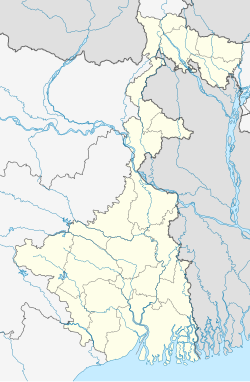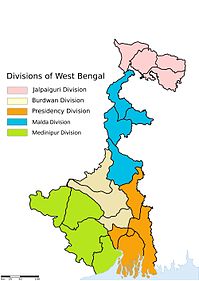Baliadanga
Baliadanga | |
|---|---|
Census Town | |
| Coordinates: 24°52′42″N 88°01′39″E / 24.878317°N 88.027365°E | |
| Country | |
| State | West Bengal |
| District | Malda |
| Area | |
• Total | 3.775 km2 (1.458 sq mi) |
| Elevation | 29 m (95 ft) |
| Population (2011) | |
• Total | 12,379 |
| • Density | 3,300/km2 (8,500/sq mi) |
| Languages (For language and religion details see Kaliachak I#Language and religion) | |
| • Official | Bengali, English |
| Time zone | UTC+5:30 (IST) |
| PIN | 732206 |
| Telephone/ STD code | 03512 |
| Vehicle registration | WB |
| Lok Sabha constituency | Maldaha Dakshin |
| Vidhan Sabha constituency | Sujapur |
| Website | malda |
Baliadanga is a census town in the Kaliachak I CD block in the Malda Sadar subdivision of Malda district in the state of West Bengal, India.
Geography
[edit]
5miles
River
River
checkpoint
Suzapur
M: municipal town, CT: census town, R: rural/ urban centre, F: Facility, H: historical centre
Owing to space constraints in the small map, the actual locations in a larger map may vary slightly
Location
[edit]Baliadanga is located at 24°52′42″N 88°01′39″E / 24.878317°N 88.027365°E.
According to the map of Kaliachak CD block in the District Census Handbook, Maldah, 2011, Silampur, Baliadanga, Alipur and Karari Chandpur form a cluster of census towns.[1]
Area overview
[edit]The area shown in the adjoining map is the physiographic sub-region known as the diara. It "is a relatively well drained flat land formed by the fluvial deposition of newer alluvium." The most note-worthy feature is the Farakka Barrage across the Ganges.[2] The area is a part of the Malda Sadar subdivision, which is an overwhelmingly rural region, but the area shown in the map has pockets of urbanization with 17 census towns, concentrated mostly in the Kaliachak I CD block.[3][4] The bank of the Ganges between Bhutni and Panchanandapur (both the places are marked on the map), is the area worst hit by left bank erosion, a major problem in the Malda area.[5] The ruins of Gauda, capital of several empires, is located in this area.[6]
Note: The map alongside presents some of the notable locations in the area. All places marked in the map are linked in the larger full screen map.
Demographics
[edit]According to the 2011 Census of India, Baliadanga had a total population of 12,379, of which 6,340 (51%) were males and 6,039 (49%) were females. Population in the age range 0–6 years was 1,706. The total number of literate persons in Baliadanga was 8,112 (76.00% of the population over 6 years).[7]
Infrastructure
[edit]According to the District Census Handbook, Maldah, 2011, Baliadanga covered an area of 3.775 km2. It had 12 km roads with open drains. The protected water-supply involved service reservoir, tap water from treated sources, hand pump. It had 2,237 domestic electric connections, 30 road lighting points. Among the medical facilities it had 1 dispensary/ health centre, 1 veterinary hospital, 25 medicine shops. Among the educational facilities, it had 9 primary schools, 2 secondary schools, 2 senior secondary schools in town, the nearest general degree college at Sultanganj 3 km away. It had 1 non-formal education centre (Sarva Shiksha Abhiyan). Among the social, recreational and cultural facilities, it had 1 cinema theatre, 1 auditorium/ community hall, 1 public library, 1 reading room. It produced wooden furniture, beedi, bakery products.[8]
Transport
[edit]Khaltipur railway station, located nearby, is on the Howrah-New Jalpaiguri line.[9]
References
[edit]- ^ "District Census Handbook Maldah, Census of India 2011, Series 20, Part XII A" (PDF). Map of Kalichak I CD block, page 639. Directorate of Census Operations, West Bengal. Retrieved 15 August 2021.
- ^ "District Census Handbook Maldah, Series 20, Part XII A" (PDF). Census of India 2011, Pages 13-15: Physiography. Directorate of Census Operations, West Bengal. Retrieved 9 November 2018.
- ^ "District Statistical Handbook 2014 Malda". Table 2.1, 2.2, 2.4b. Department of Statistics and Programme Implementation, Government of West Bengal. Retrieved 9 November 2018.
- ^ "C.D. Block Wise Primary Census Abstract Data(PCA)". West Bengal – District-wise CD Blocks. Registrar General and Census Commissioner, India. Retrieved 9 November 2018.
- ^ Banerjee, Manisha. "A Report on the Impact of Farakka Barrage on the Human Fabric, November 1999" (PDF). The social impact of erosion, pp 13-14. South Asia Network On Dams, Rivers and People, New Delhi: 110 088 India. Archived from the original (PDF) on 8 August 2017. Retrieved 16 August 2021.
- ^ "District Human Development Report, Malda". pages 3-4: Malda in Historical Perspective. Department of Planning, Statistics and Programme Monitoring, Government of West Bengal. Retrieved 6 November 2018.
- ^ "District Census Handbook, Maldah, Series 20, Part XII B" (PDF). Rural PCA-C.D. blocks wise Village Primary Census Abstract, location no. 313621, page 26-27. Directorate of Census Operations West Bengal. Retrieved 14 August 2021.
- ^ "District Census Handbook Maldah, Census of India 2011, Series 20, Part XII A" (PDF). Section II Town Directory, Pages 775-786; Statement I: Status and Growth History, Page 775; Statement III: Civic & Other Amenities, Pages 779-780; Statement IV: Medical Facilities 2009, Pages 781-782; Section V: Educational, Recreational and Cultural Facilities: Pages 783-785; Statement VI: Industry & Banking, Page 786. Directorate of Census Operations, West Bengal. Retrieved 8 August 2021.
- ^ "KTJ Khaltipur". IndiaRailInfo. Retrieved 16 August 2021.



